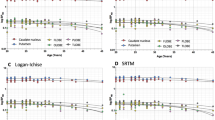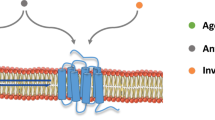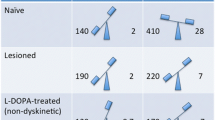Summary
In post-mortem putamen samples from 27 schizophrenics and 27 controls D2 receptors were measured by Scatchard analysis using3H-spiperone as a ligand. Maximum number of binding sites (Bmax) and apparent dissociation constant (KD) were significantly increased only in patients in whom neuroleptic medication had been given within a three-month period before death. When the neuroleptic medication had been withdrawn at least 3 month before death, there was a slight, but not significant, reduction in Bmax values and unchanged KD values. Withdrawal of neuroleptic drugs was followed by a normalization of the KD values within 2 weeks and a slower reduction of Bmax values. There were 6 schizophrenic patients with mainly positive schizophrenic symptoms and 17 patients with mainly negative symptoms; positive schizophrenic symptoms were not related to higher Bmax values. There was no difference in3H-spiperone binding between patients with and without movement disorders (tardive dyskinesia or extrapyramidal symptoms).
Similar content being viewed by others
References
Asnis GM, Sachar EJ, Langer G, Halpern FS, Fink M (1979) Normal prolactin responses in tardive dyskinesia. Psychopharmacology 66: 247–250
Bowers MB (1974) Central dopamine turnover in schizophrenic syndromes. Arch Gen Psychiatry 31: 50–54
Crawley JCW, Crow TJ, Johnstone EC, Oldland SRD, Owen F, Owens DGC, Smith T, Veall N, Zanelli GD (1986) Uptake of77Br-spiperone in the striata of schizophrenic patients and controls. Nuclear Med Commun 7: 599–607
Cross AJ, Crow TJ, Ferrier IN, Johnson JA, Johnstone EC, Owen F, Owens DGC, Poulter M (1985) Chemical and structural changes in the brain in patients with movement disorders. In: Casey DE, Chase TN, Christensen AV, Gerlach J (eds) Dyskinesia: research and treatment. Springer Verlag, Berlin Heidelberg New York Tokyo, pp 104–110
Cross AJ, Crow TJ, Owen F (1981)3H-Flupenthixol binding in post-mortem brains of schizophrenics: evidence for a selective increase in dopamine D2 receptors. Psychopharmacology 74: 122–124
Crow TJ, Cross AJ, Johnstone EC, Owen F, Owens DGC, Waddington JL (1982) Abnormal involuntary movements in schizophrenia: are they related to the disease process or its treatment? Are they associated with changes in dopamine receptors? J Clin Psychopharmacol 2: 336–340
Crow TJ, Owen F, Cross AJ, Ferrier N, Johnstone EC, McCreadie RM, Owens DGC, Poulter M (1981) Neurotransmitter enzymes and receptors in post-mortem brain in schizophrenia: evidence that an increase in D2 dopamine receptors is associated with the Type I Syndrome. In: Riederer P, Usdin E (eds) Transmitter biochemistry of human brain tissue. Macmillan, London, pp 85–96
Farde L, Wiesel FA, Hall H, Halldin C, Stone-Elander S, Sedvall G (1987) No D2 receptor increase in PET study of schizophrenia. Arch Gen Psychiatry 44: 671–672
Feighner JP, Robins E, Guze SB, Woodruff RA, Winokur G, Munoz R (1972) Diagnostic criteria for use in psychiatric research. Arch Gen Psychiatry 26: 57–63
Fibiger HC, Lloyed KG (1984) Neurobiological substrates of tardive dyskinesia: the GABA hypothesis. Trends Neurosci 12: 462–464
Haberland N, Hetey L (1987) Studies in postmortem dopamine uptake II. Alterations of the synaptosomal catecholamine uptake in postmortem brain regions in schizophrenia. J Neural Transm 68: 303–313
Herold S, Leenders KL, Turton DR, Kensett MJ, Pike VW, Clark JC, Brooks DJ, Crow TJ, Owen F, Cooper S, Johnstone EC (1985) Dopamine receptor binding in schizophrenic patients as measured with11C-methylspiperone and PET. J Cereb Blood Flow Metab 5: S 191-S 192
Hess EJ, Bracha S, Kleinman JE, Creese I (1987) Dopamine receptor subtype imbalance in schizophrenia. Life Sci 40: 1487–1497
Kebabian JW, Calne DB (1979) Multiple receptors for dopamine. Nature 277: 93–96
Klawans HL, Rubovits R (1972) An experimental model of tardive dyskinesia. J Neural Transm 33: 235–246
Lee T, Seeman P, Tourtellotte WW, Farley IJ, Hornykiewicz O (1978) Binding of3H-neuroleptics and3H-apomorphine in schizophrenic brains. Nature 274: 897–900
Mackay AVP, Iversen LL, Rossor M, Spokes E, Bird E, Arregui A, Creese I, Snyder SH (1982) Increased brain dopamine and dopamine receptors in schizophrenia. Arch Gen Psychiatry 39: 991–997
Mackenzie RG, Zigmond MJ (1985) Chronic neuroleptic treatment increases D-2 but not D-l receptors in rat striatum. Eur J Pharmacol 113: 159–165
Matthysse S (1973) Antipsychotic drug actions: a clue to the neuropathology of schizophrenia? Fed Proc 32: 200–205
Mita T, Hanada S, Nishino N, Kuno T, Nakai H, Yamadori T, Mizoi Y, Tanaka C (1986) Decreased serotonin S2 and increased dopamine D2 receptors in chronic schizophrenics. Biol Psychiatry 21: 1407–1414
Murugaiah K, Theodorou A, Mann S, Clow A, Jenner P, Marsden CD (1982) Chronic continuous administration of neuroleptic drugs alters cerebral dopamine receptors and increases spontaneous dopaminergic action in the striatum. Nature 296: 570–572
Owen F, Cross AJ, Crow TJ, Longden A, Poulter M, Riley GJ (1978) Increased dopaminereceptor sensitivity in schizophrenia. Lancet II: 223–226
Owen F, Cross AJ, Poulter M, Waddington JL (1979) Change in the characteristics of3H-spiperone binding to rat striatal membranes after acute chlorpromazine administration: effects of buffer washing of membranes. Life Sci 25: 385–390
Owen F, Cross AJ, Waddington JL, Poulter M, Gamble SJ, Crow TJ (1980) Dopaminemediated behaviour and3H-spiperone binding to striatal membranes in rats after nine months haloperidol administration. Life Sci 26: 55–59
Owen R, Owen F, Poulter M, Crow TJ (1984) Dopamine D2 receptors in substantia nigra in schizophrenia. Brain Res 299: 152–154
Pimoule C, Schoemaker H, Reynolds GP, Langer SZ (1985) (3H) SCH 23390 labeled D1 dopamine receptors are unchanged in schizophrenia and Parkinson's disease. Eur J Pharmacol 114: 235–237
Post RM, Fink E, Carpenter WT, Goodwin FK (1975) Cerebrospinal fluid amine metabolites in acute schizophrenia. Arch Gen Psychiatry 32: 1063–1069
Reynolds GP (1983) Increased concentrations and lateral asymmetry of amygdala dopamine in schizophrenia. Nature 305: 527–529
Reynolds GP, Reynolds LM, Riederer P, Jellinger K, Gabriel E (1980) Dopamine receptors and schizophrenia: drug effect or illness? Lancet II: 1251
Reynolds GP, Riederer P, Jellinger K, Gabriel E (1981) Dopamine receptors and schizophrenia: the neuroleptic drug problem. Neuropharmacology 20: 1319–1320
Schotte A, Maloteaux JM, Laduron PM (1983) Characterization and regional distribution of serotonin S2-receptors in human brain. Brain Res 276: 231–235
Sedvall G, Farde L, Persson A, Wiesel FA (1986) Imaging of neurotransmitter receptors in the living human brain. Arch Gen Psychiatry 43: 995–1005
Seeman P (1987) Dopamine receptors and the dopamine hypothesis of schizophrenia. Synapse 1: 133–152
Seeman P, Bzowej NH, Guan HC, Bergeron C, Reynolds GP, Bird ED, Riederer P, Jellinger K, Tourtellotte WW (1987) Human brain D 1 and D2 dopamine receptors in schizophrenia, Alzheimer's, Parkinson's, and Huntington's diseases. Neuropsychopharmacology 1: 5–15
Seeman P, Ulpian C, Bergeron C, Riederer P, Jellinger K, Gabriel E, Reynolds GP, Tourtellotte WW (1984a) Bimodal distribution of dopamine receptor densities in brains of schizophrenics. Science 225: 728–731
Seeman P, Ulpian C, Wreggett KA, Wells JW (1984b) Dopamine receptor parameters detected by (3H) spiperone depend on tissue concentration: analysis and examples. J Neurochem 43: 221–235
Tamminga CA, Smith RC, Pandey G, Frohman LA, Davis JM (1977) A neuroendocrine study of supersensitivity in tardive dyskinesia. Arch Gen Psychiatry 34: 1199–1203
Toru M, Nishikawa T, Semba J, Mataga N, Takashima M, Noda K, Shibuya H (1982) Increased dopamine metabolism in the putamen and caudate in schizophrenic patients. In: Namba M, Kaiya H (eds) Psychobiology of schizophrenia. Pergamon Press, Oxford, pp 235–240
Tripodianakis J, Markianos M, Garelis E (1983) Neurochemical studies on tardive dyskinesia. I. Urinary homovanillic acid and plasma prolactin. Biol Psychiatry 18: 337–345
Van Rossum JM (1966) The significance of dopamine-receptor blockade for the action of neuroleptic drugs. Arch Int Pharmacodyn Ther 160: 492–494
Waddington JL, Cross AJ, Gamble SJ, Bourne RC (1983) Spontaneous orofacial dyskinesia and dopaminergic function in rats after 6 months of neuroleptic treatment. Science 220: 530–532
Wong DF, Wagner HN, Tune LE, Dannals RF, Pearlson GD, Links JM, Tamminga CA, Broussolle EP, Ravert HT, Wilson AA, Toung JKT, Malat J, Williams JA, O'Tuama LA, Snyder SH, Kuhar MJ, Gjedde A (1986) Positron emission tomography reveals elevated D2 dopamine receptors in drug-naive schizophrenics. Science 234: 1558–1563
Author information
Authors and Affiliations
Rights and permissions
About this article
Cite this article
Kornhuber, J., Riederer, P., Reynolds, G.P. et al. 3H-spiperone binding sites in post-mortem brains from schizophrenic patients: Relationship to neuroleptic drug treatment, abnormal movements, and positive symptoms. J. Neural Transmission 75, 1–10 (1989). https://doi.org/10.1007/BF01250639
Received:
Accepted:
Issue Date:
DOI: https://doi.org/10.1007/BF01250639




